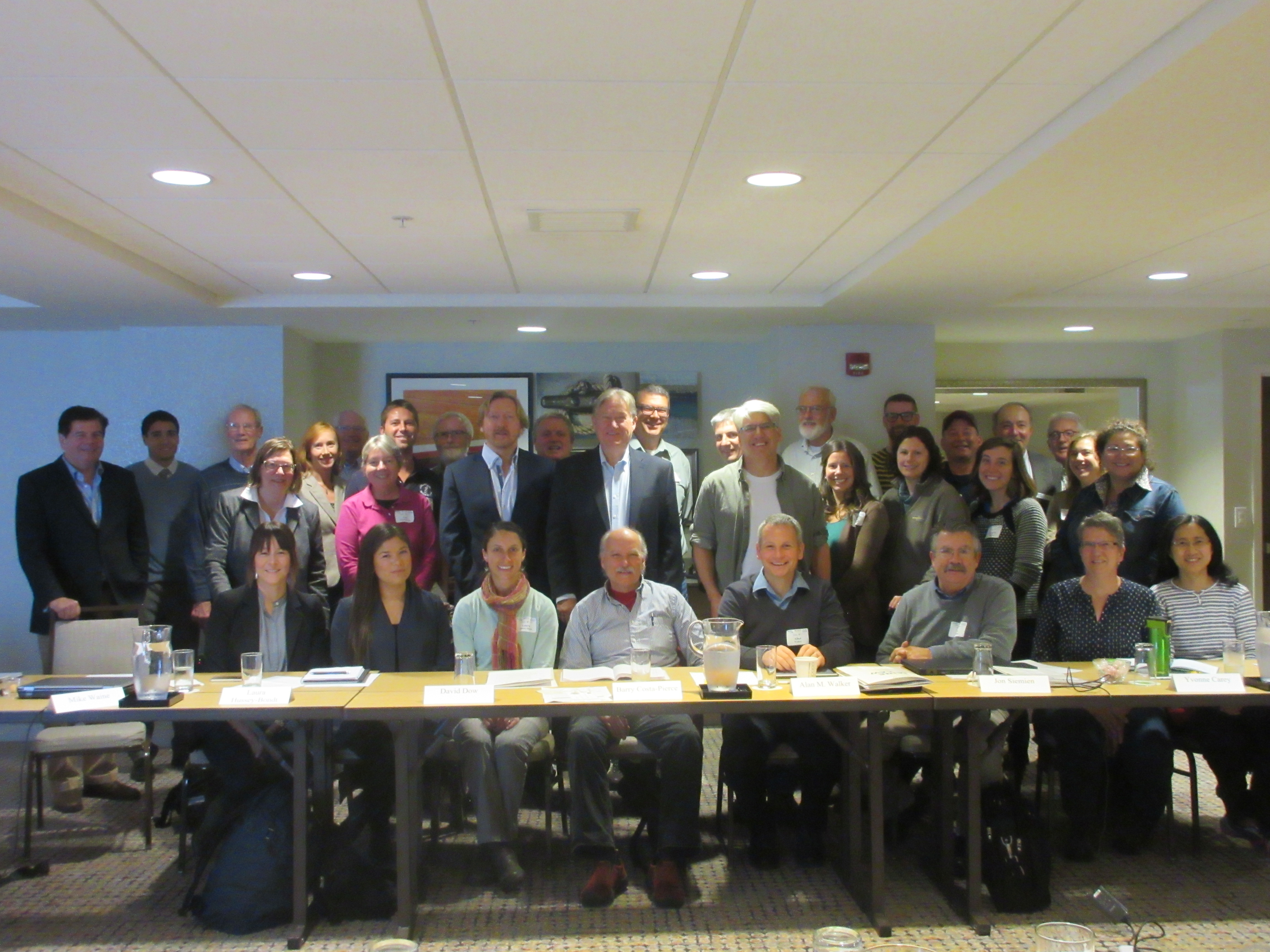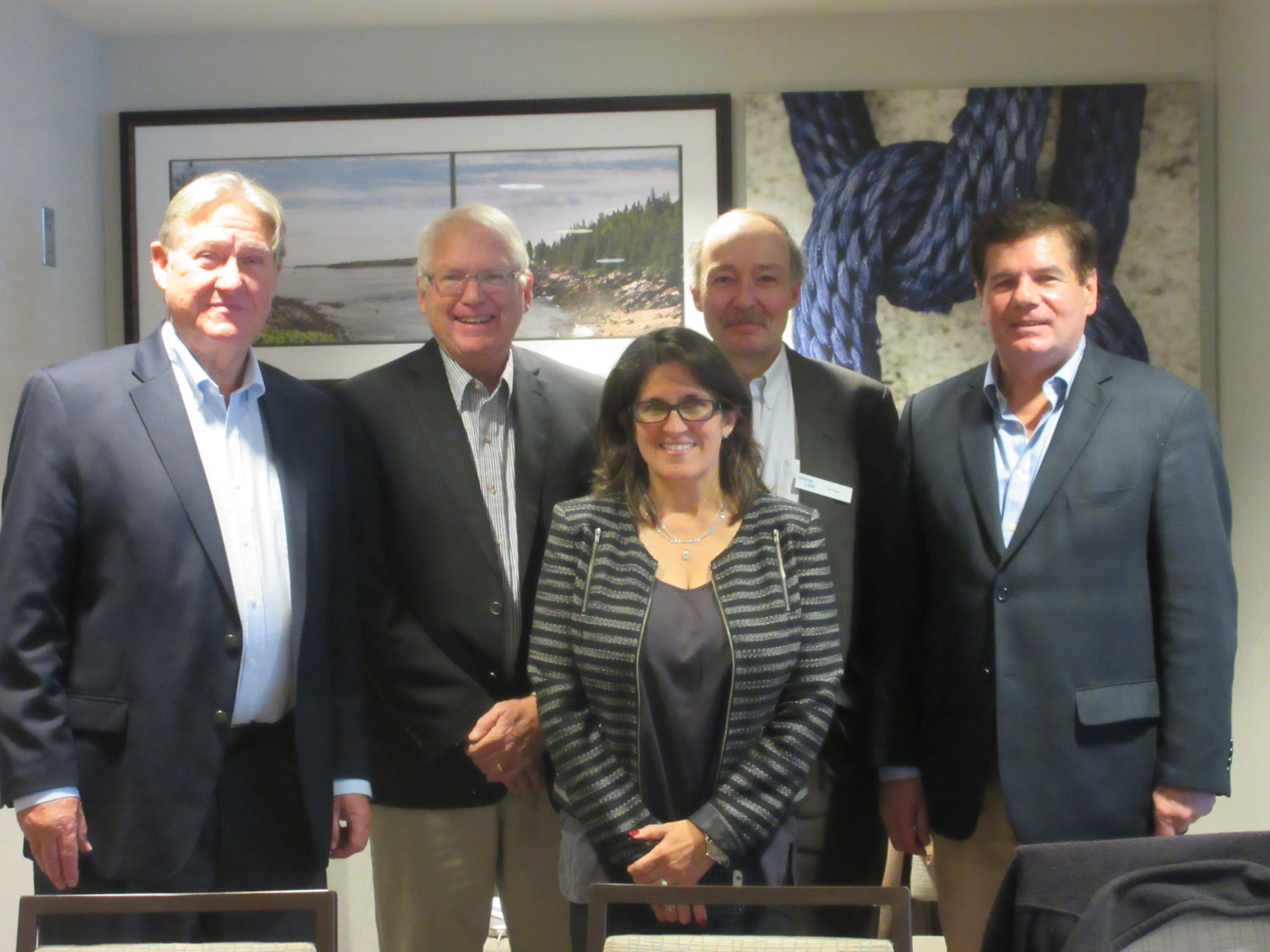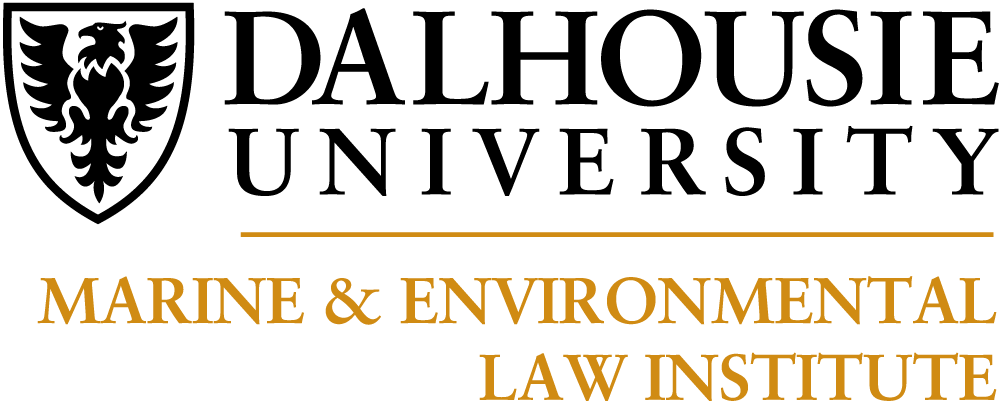Sargasso Sea Commission Sponsors an American Eel Symposium in Portland, Maine
 From 23-25 October 2015, the Sargasso Sea Commission -- together with the Marine & Environmental Law Institute of Dalhousie University, Ocean Tracking Network, Social Sciences and Humanities Research Council of Canada, Center for Oceans and Coastal Law at the University of Maine School of Law, Ocean and Coastal Law Journal, and the Gulf of Maine Research Institute -- sponsored an interactive symposium in Portland Maine on conservation of the American eel. Over 30 eel experts and stakeholders from government, academia, commercial and
From 23-25 October 2015, the Sargasso Sea Commission -- together with the Marine & Environmental Law Institute of Dalhousie University, Ocean Tracking Network, Social Sciences and Humanities Research Council of Canada, Center for Oceans and Coastal Law at the University of Maine School of Law, Ocean and Coastal Law Journal, and the Gulf of Maine Research Institute -- sponsored an interactive symposium in Portland Maine on conservation of the American eel. Over 30 eel experts and stakeholders from government, academia, commercial and
 conservation interests spent the weekend reviewing key scientific, policy and cultural issues surrounding the American eel, a species that is known to be depleted and whose complex life cycle and vast range and migrations are one of the most mysterious on Earth. The Ocean and Coastal Law Journal at Maine Law School will publish a symposium journal summarizing the proceedings of the conference.
conservation interests spent the weekend reviewing key scientific, policy and cultural issues surrounding the American eel, a species that is known to be depleted and whose complex life cycle and vast range and migrations are one of the most mysterious on Earth. The Ocean and Coastal Law Journal at Maine Law School will publish a symposium journal summarizing the proceedings of the conference.
 The American eel (Anguilla rostrata) is a catadromous species which lives most of its life in fresh and brackish water habitats throughout western
The American eel (Anguilla rostrata) is a catadromous species which lives most of its life in fresh and brackish water habitats throughout western and central North America, the Caribbean and the very north of South America. The mature eels then migrate thousands of miles to the Sargasso Sea, south of Bermuda, where they spawn and die; the European eel (Anguilla anguilla) is also known to spawn here. One of the workshop participants, Dr. Martin Castonguay, just released an important paper with a team of scientists that tracked for the first time an adult American eel from the coast of Canada 2,400 km to its spawning area in the Sargasso Sea. Although the spawning has never been witnessed, it is known that the young leptocephali find their way back to the Americas to begin the cycle again.
and central North America, the Caribbean and the very north of South America. The mature eels then migrate thousands of miles to the Sargasso Sea, south of Bermuda, where they spawn and die; the European eel (Anguilla anguilla) is also known to spawn here. One of the workshop participants, Dr. Martin Castonguay, just released an important paper with a team of scientists that tracked for the first time an adult American eel from the coast of Canada 2,400 km to its spawning area in the Sargasso Sea. Although the spawning has never been witnessed, it is known that the young leptocephali find their way back to the Americas to begin the cycle again.
 There is significant concern about the conservation status of both the European and American eel, both of which are classified as endangered on the IUCN Red List of Threatened Species - the European eel listed as critically endangered. This status is–due to a suite of impacting factors that have resulted in a decline in recruitment and escapement for migration to the Sargasso Sea over the past four decades. The American eel is a candidate for protection under species at risk legislation in both the US and Canada.
There is significant concern about the conservation status of both the European and American eel, both of which are classified as endangered on the IUCN Red List of Threatened Species - the European eel listed as critically endangered. This status is–due to a suite of impacting factors that have resulted in a decline in recruitment and escapement for migration to the Sargasso Sea over the past four decades. The American eel is a candidate for protection under species at risk legislation in both the US and Canada. 
 Participants sent by the Unama’ki Institute of Natural Resources, the Maliseet Nation Conservation Council, and Chief Moore of the Passamaquoddy Tribe joined with representatives of the Governments of Canada and the US, and participants from commercial eel and elver fisheries as well as hydropower firms explored the interactions between indigenous approaches, commercial interests and local, state, regional and national regulation. Representatives from Fisheries and Oceans Canada sat at the table with experts from the Maine Department of Marine Resources US Fish & Wildlife Service and the Atlantic States Marine Fisheries Council discussing how eel conservation is approached respectively in Canada and the US.
Participants sent by the Unama’ki Institute of Natural Resources, the Maliseet Nation Conservation Council, and Chief Moore of the Passamaquoddy Tribe joined with representatives of the Governments of Canada and the US, and participants from commercial eel and elver fisheries as well as hydropower firms explored the interactions between indigenous approaches, commercial interests and local, state, regional and national regulation. Representatives from Fisheries and Oceans Canada sat at the table with experts from the Maine Department of Marine Resources US Fish & Wildlife Service and the Atlantic States Marine Fisheries Council discussing how eel conservation is approached respectively in Canada and the US.
The participation of experts from the Sargasso Sea Commission, the Convention on Migratory Species Secretariat, the London Zoological Society
 and UK Centre for Environment, Fisheries and Aquaculture Science (CEFAS) facilitated comparisons with the ways in which the conservation of the European and Japanese eel is being addressed.
and UK Centre for Environment, Fisheries and Aquaculture Science (CEFAS) facilitated comparisons with the ways in which the conservation of the European and Japanese eel is being addressed.
 Participants noted one of the unique significance of this gathering was its pioneering informal, multilateral stakeholder approach – a process that has achieved results for other species and locations but has not yet been applied to address American eel conservation. The workshop participants encouraged continuing and expanding the process to include Caribbean stakeholders as well.
Participants noted one of the unique significance of this gathering was its pioneering informal, multilateral stakeholder approach – a process that has achieved results for other species and locations but has not yet been applied to address American eel conservation. The workshop participants encouraged continuing and expanding the process to include Caribbean stakeholders as well.
The workshop represented a concrete effort to build both informal networks and towards a more formal larger framework on multilateral cooperation in eel conservation. Dr. Bradnee Chambers, Executive Secretary of the Convention on Migratory Species (CMS) encouraged the participants to look at possible opportunities to use mechanisms under the CMS for American eel conservation efforts.
in eel conservation. Dr. Bradnee Chambers, Executive Secretary of the Convention on Migratory Species (CMS) encouraged the participants to look at possible opportunities to use mechanisms under the CMS for American eel conservation efforts.
 The cooperative and constructive approach of the symposium participants created an enthusiasm for additional collaboration. It became clear that efforts to better
The cooperative and constructive approach of the symposium participants created an enthusiasm for additional collaboration. It became clear that efforts to better  understand the situation of the American eels in the Caribbean are sorely needed and that current structures also leave room for fuller incorporation of First Nation perspectives and improved stakeholder coordination and communication.
understand the situation of the American eels in the Caribbean are sorely needed and that current structures also leave room for fuller incorporation of First Nation perspectives and improved stakeholder coordination and communication.



This group of participants also clearly recognized the need to continue and create additional formal and informal mechanisms or channels to  continue the dialogue started in Portland on the American eel. The group agreed to explore future opportunities to work together to develop multilateral opportunities for scientific advancement, stock assessment and other necessary steps.
continue the dialogue started in Portland on the American eel. The group agreed to explore future opportunities to work together to develop multilateral opportunities for scientific advancement, stock assessment and other necessary steps.




Program Agenda and Presentations
Session One: Science Panel
Moderator, James McCleaveOverview of American Eel Scientific Research and Understandings
• Scientific Overview of the American Eel from Canada to the Caribbean. James McCleave, Professor Emeritus, School of Marine Sciences, University of Maine.
• Distribution, Biology, and Conservation of American Eels in Canada and North America. David Cairns, Department of Fisheries and Oceans.
• US Scientific Approaches and Challenges. Barry Costa-Pierce, Marine Science Centre, University of New England.
Session Two: Socio-Economic Panel
Moderator, David VanderZwaagThe Socio-Economic and Cultural Significance of American Eels: Overview of eel fisheries, socio-economic uses, international eel markets, dominance of Asian aquaculture, role of the American eel for aquaculture seed stock and for the consumption market.
• Incorporating First Nation Perspectives in Eel Science, Species at Risk and Management. Shelley Denny, Director of Aquatic Research and Stewardship, Unama’ki Institute of Natural Resources and Amber Giles, Environmental Technician, Maliseet Nation Conservation Council.
• First Nation Perspective on American Eel Fisheries. David Dow, Ocean Policy Coordinator for Chief Moore of the Passamaquoddy Tribe.
• Description of Commercial Eel Fisheries in North America. Mitch Feigenbaum, American Eel Sustainability Association.
• Socio-Economic and Scientific Contributions of Canadian Glass Eel Harvesters. Genna Carey, Committee Chair, Canadian Committee for a Sustainable Eel Fishery, Inc.
Session Three: Threats to Eel
Moderator, Jeff Thaler
• Overview of Major Threats. Jeff Thaler, visiting Professor of Energy Law, University of Maine School of Law.
• Designing Upstream Eel Passage at Hydroelectric Facilities. Jon Truebe, Fisheries Engineer, Lakeside Engineering Inc.
• American Eels from a Maine Regulatory Agency Perspective. Gail Wippelhauser, Marine Resources Scientist, Maine Department of Marine Resources.
• Listing Decision and Management in the US. Steven Shepard, Fish and Wildlife Biologist, US Fish & Wildlife Service.
Session Four: European Eel Experience
Moderator, David Freestone
Lessons from Other Eel Research and Conservation: European eel and international legal experts will give a comparative perspective.
• The Sargasso Sea and the Sargasso Sea Commission. David Freestone, Executive Secretary, Sargasso Sea Commission.
• Prioritising Conservation and Management of Anguillid Eels. Matthew Gollock, Zoological Society of London, Chair of the IUCN Anguillid working group.
• Key Points in the Recent Management of European Eel across Europe and Beyond. Alan Walker, Representative from CEFAS; ICES WGEEL Chair.
Session Five: Law and Policy
Moderator, Charles Norchi
Law and Policy Frameworks for the Conservation and Sustainable Use of American Eels: Exploring global, regional, Canadian and US policy, management and coordination.
• Sustaining American Eels: Navigating the International Law and Policy Seascape. David VanderZwaag, Marine & Environmental Law Institute, Dalhousie University.
• The Great Lakes Fishery Commission and the Conservation of Eels. John M. Dettmers, Fishery Management Director, Great Lakes Fishery Commission.
• Commentary on the USA Legal Framework. Rachel White Sears, Attorney at Law.
• The Canadian Management Framework for American Eel. Laura Hussey-Bondt, Senior Advisor, Fisheries Management, Fisheries and Oceans Canada – Maritimes Region.
• US Overview of American Eel Management. Mike Waine, Senior Fishery Management Plan Coordinator, Atlantic States Marine Fisheries Council.
Session Six: Future Directions and Concluding Remarks
Keynote Address and Concluding Remarks: Global Perspective on Migratory Species. Bradnee Chambers, Convention on Migratory Species Secretariat.
Possible Future Scientific, Law and Policy Directions: Where do we go from here? We will try to develop a concrete summary of proposed actions to stimulate progress on the American Eel.
• Summary discussion with panel moderators and a small group of invited panelists with the goal of developing recommendations for next steps and action items.
• Open discussion period to refine concrete next steps and proposals for future.






